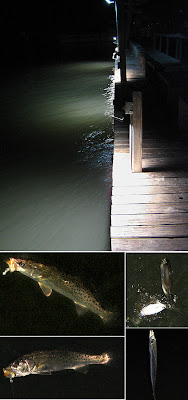
There is nothing like the pier in the summer time, and seeing the beach, the boats, the surf, the birds and the fish.
If you have never tried salt water fishing, the sheer variety of fish you see always makes it fun. Above are photos from a visit on the first day of summer at the Horace Caldwell pier in Port Aransas, Texas. It's a standard fishing pier just like you'll find on any stretch of the U.S. coast, a couple hundred yards long with a T-shaped ending.
The first four fish pictured are prized speckled trout that were biting on live shrimp and on lures shaped like shrimp or minnows. But there were many other kinds caught, and pictured are a blue runner, a sand shark and a four-foot scalloped hammerhead shark.
The pier fishing experience is one of the nicest under the right conditions. On this day you'll notice the pier has the unusual luxury of plenty of open room with extra space for casting. Beginners might want to avoid fishing on crowded piers. Also, this pier, which has been here for decades, recently banned alcohol. That's had a good effect for the family experience. The crowds did arrive when the sun got lower on this weekend, and there were many friendly people having good times.
Fishing on a pier is very different from fishing in a freshwater lake, with very different equipment. That four pound line that's so effective at a lake just won't work on a saltwater pier. Here a three or four pound fish — possibly with sharp teeth — is likely to bite (and a three HUNDRED pound fish is not out of the question!). With a light freshwater outfit you probably wouldn't be able to pull a fish up through the air before the line broke, and in fact, you wouldn't even be likely to see the fish before feeling the snap of the line.
The stores that cater to tourists here offered acceptable saltwater fishing rod-and-reel combos at reasonable prices — $25 to $35. Some have large pushbutton reels with 14-to-20 pound line, and very heavy rods. If push button reels are the only type you can use, these will work fine, and you should be able to land up to a five - or possibly even a 10-pound fish. (You'll need help getting large fish up onto the pier. Friendly people will be glad to help, and you'll need to accept their hospitality. If you're really lucky, someone will have a "drop-net," a circular net that is dropped down to the water to bring the fish up.)
There's a lot you should know before trying saltwater fishing, including: which fish can hurt you (including jellyfish), which bait to use, how to put the bait on the hook, how to attach big hooks, big lead weights and steel "leaders" to your line — all subjects coming up here.
 The whiting is not a rare fish in the Gulf and Atlantic, but it's also one you don't often see in huge numbers. After sunset June 23, the whiting were present in huge numbers at Bob Hall Pier in the Gulf of Mexico in Corpus Christi, Texas.
The whiting is not a rare fish in the Gulf and Atlantic, but it's also one you don't often see in huge numbers. After sunset June 23, the whiting were present in huge numbers at Bob Hall Pier in the Gulf of Mexico in Corpus Christi, Texas.
